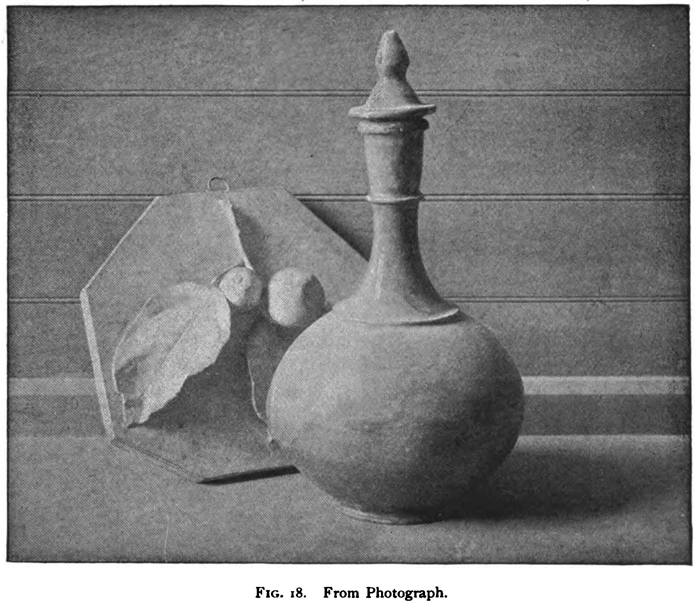Home > Directory of Drawing Lessons > How to Improve Your Drawings > Drawing Reflected Light > How to Draw Reflected Lights
How to Draw Reflected Lights by Drawing Graduated Tones and Values and by Drawing Shadows Very Dark and Highlights Very Light
|
|
REFLECTED LIGHT.Varies in strength.With any given illumination the strength of reflected lights depends upon the smoothness of the objects on which they are found, and upon their surroundings. A mirror in the form of a sphere would reflect the forms and colors of objects about it so perfectly that the effects of light and shadow would be entirely destroyed by the reflections. Perfect reflecting surfaces are seldom found in common objects, but polished silverware gives a near approach to perfect reflection ; the reflection is sharp and gives clearly the form and color of the objects reflected. Polished objects give clear reflections of dark objects as well as of light ones ; and, to be exact, we should require another division of the effects due to light and shade, namely, reflected darks. These reflected darks are generally considered as the parts of the shadow which are not lightened by reflected lights. The student, however, should not study from objects whose surfaces are highly polished until quite proficient in representing the simple effects of light and shade upon unpolished objects. Makes the shadow visible.The " light " of any object is the surface upon which direct rays of light fall. By direct rays is meant rays from the sun, the moon, or any artificial light, and also the rays from the window by which any studio or room is lighted. That part of the surface of any object which receives no direct rays is called the " shadow," and the lightest parts of any shadow surface are called the "reflected lights." Shadow surfaces receive no direct rays and would appear uniformly dark if they did not receive light which is reflected to them from the light surfaces of objects about them. If not for this indirect and irregularly reflected light shadow surfaces would be visible as darks by reason of the light surfaces about them, but no detail would be seen in any shadow surface. But, as a matter of fact, every part of the surface of any object receives light which is irregularly reflected to it from all directions; and the stronger these reflected rays, the lighter are the shadow surfaces, and the more prominent is any detail in them. In Fig. 16 the light top of the plinth is reflected in the bottle as a decided form, bounded by curved lines meeting at points which are the reflections of the corners ; and the plinth in Fig. 17 is reflected in a similar way in the bottle upon it. Is generally dark.Objects less smooth than the bottles of Figs. 16 and 17 have reflected lights which cause slight gradations in the mass of the shadow (see Fig. 18); and generally the student will find that in the effect of the whole, reflected lights are not lights but darks, which are simply less dark than the strongest parts of the shadow. In looking at detail, whether in the mass of the light or in the mass of shadow, the student should blur his eyes and see if the detail belongs to the light or to the dark. He should ask himself, "Does the detail appear light or dark in the effect of the whole?" The tendency is to exaggerate the reflected lights in the shadow just as much as the grays in the mass of the light, and if the student does not often apply the tests explained in Chap. II, he will not realize that generally the lights which he sees in the mass of the shadow are darks, and the grays which he sees in the mass of the light are lights. May come in the light.The light top of the plinth in Fig. 14 gives bright reflections on the bands upon the lower part of the pitcher. These are reflected lights, though they come in the mass of the light upon the pitcher, and we see that a light object may so reflect that it lightens the light as well as the shadow of any object. The reflection of any light object upon any surface in light or in shadow is never as light as the reflected object, and the reflection of a dark object is not as dark as the object, for the light reflection is darkened by losing the light which the reflecting surface absorbs, while the dark reflection is lightened by the surface reflecting diffused light received from other objects. |
Privacy Policy ...... Contact Us










